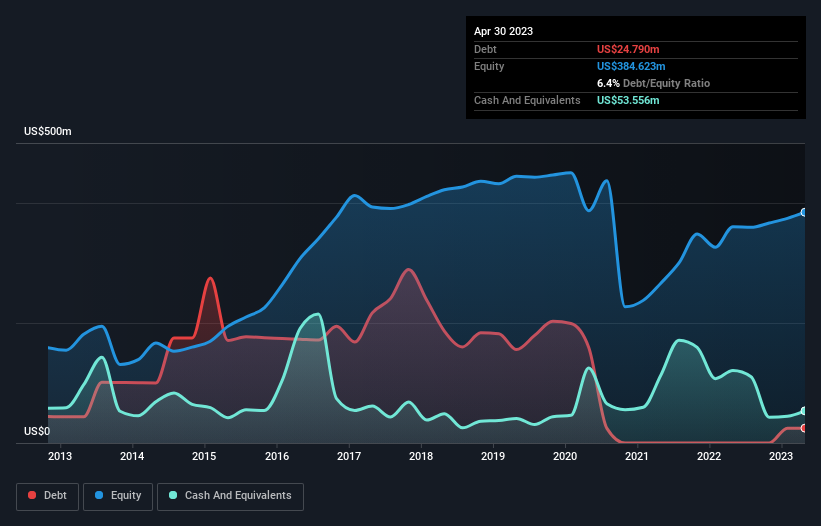
David Iben put it well when he said, 'Volatility is not a risk we care about. What we care about is avoiding the permanent loss of capital.' It's only natural to consider a company's balance sheet when you examine how risky it is, since debt is often involved when a business collapses. As with many other companies Smith & Wesson Brands, Inc. (NASDAQ:SWBI) makes use of debt. But should shareholders be worried about its use of debt?
Why Does Debt Bring Risk?
Debt and other liabilities become risky for a business when it cannot easily fulfill those obligations, either with free cash flow or by raising capital at an attractive price. Part and parcel of capitalism is the process of 'creative destruction' where failed businesses are mercilessly liquidated by their bankers. However, a more frequent (but still costly) occurrence is where a company must issue shares at bargain-basement prices, permanently diluting shareholders, just to shore up its balance sheet. Of course, plenty of companies use debt to fund growth, without any negative consequences. The first step when considering a company's debt levels is to consider its cash and debt together.
View our latest analysis for Smith & Wesson Brands
What Is Smith & Wesson Brands's Net Debt?
The image below, which you can click on for greater detail, shows that at April 2023 Smith & Wesson Brands had debt of US$24.8m, up from none in one year. But on the other hand it also has US$53.6m in cash, leading to a US$28.8m net cash position.

A Look At Smith & Wesson Brands' Liabilities
We can see from the most recent balance sheet that Smith & Wesson Brands had liabilities of US$87.2m falling due within a year, and liabilities of US$69.5m due beyond that. On the other hand, it had cash of US$53.6m and US$56.3m worth of receivables due within a year. So its liabilities outweigh the sum of its cash and (near-term) receivables by US$46.8m.
Since publicly traded Smith & Wesson Brands shares are worth a total of US$485.0m, it seems unlikely that this level of liabilities would be a major threat. However, we do think it is worth keeping an eye on its balance sheet strength, as it may change over time. Despite its noteworthy liabilities, Smith & Wesson Brands boasts net cash, so it's fair to say it does not have a heavy debt load!
The modesty of its debt load may become crucial for Smith & Wesson Brands if management cannot prevent a repeat of the 78% cut to EBIT over the last year. When it comes to paying off debt, falling earnings are no more useful than sugary sodas are for your health. When analysing debt levels, the balance sheet is the obvious place to start. But ultimately the future profitability of the business will decide if Smith & Wesson Brands can strengthen its balance sheet over time. So if you're focused on the future you can check out this free report showing analyst profit forecasts.
Finally, a company can only pay off debt with cold hard cash, not accounting profits. Smith & Wesson Brands may have net cash on the balance sheet, but it is still interesting to look at how well the business converts its earnings before interest and tax (EBIT) to free cash flow, because that will influence both its need for, and its capacity to manage debt. Over the most recent three years, Smith & Wesson Brands recorded free cash flow worth 52% of its EBIT, which is around normal, given free cash flow excludes interest and tax. This free cash flow puts the company in a good position to pay down debt, when appropriate.
Summing Up
While it is always sensible to look at a company's total liabilities, it is very reassuring that Smith & Wesson Brands has US$28.8m in net cash. So we are not troubled with Smith & Wesson Brands's debt use. The balance sheet is clearly the area to focus on when you are analysing debt. However, not all investment risk resides within the balance sheet - far from it. For example, we've discovered 3 warning signs for Smith & Wesson Brands (1 is a bit concerning!) that you should be aware of before investing here.
If you're interested in investing in businesses that can grow profits without the burden of debt, then check out this free list of growing businesses that have net cash on the balance sheet.
New: Manage All Your Stock Portfolios in One Place
We've created the ultimate portfolio companion for stock investors, and it's free.
• Connect an unlimited number of Portfolios and see your total in one currency
• Be alerted to new Warning Signs or Risks via email or mobile
• Track the Fair Value of your stocks
Have feedback on this article? Concerned about the content? Get in touch with us directly. Alternatively, email editorial-team (at) simplywallst.com.
This article by Simply Wall St is general in nature. We provide commentary based on historical data and analyst forecasts only using an unbiased methodology and our articles are not intended to be financial advice. It does not constitute a recommendation to buy or sell any stock, and does not take account of your objectives, or your financial situation. We aim to bring you long-term focused analysis driven by fundamental data. Note that our analysis may not factor in the latest price-sensitive company announcements or qualitative material. Simply Wall St has no position in any stocks mentioned.
About NasdaqGS:SWBI
Smith & Wesson Brands
Designs, manufactures, and sells firearms worldwide.
Undervalued with excellent balance sheet.
Similar Companies
Market Insights
Community Narratives




